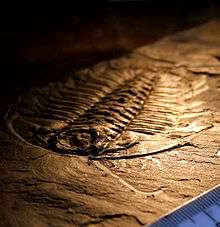Sirius Passet
| Sirius Passet Stratigraphic range: Cambrian Series 2 ~523–518 Ma | |
|---|---|
 Halkieria, an iconic fossil of the Sirius Passet | |
| Type | Geological formation |
| Lithology | |
| Primary | ? |
| Location | |
| Coordinates | 82°47.6′N 42°13.7′W / 82.7933°N 42.2283°WCoordinates: 82°47.6′N 42°13.7′W / 82.7933°N 42.2283°W |
| Region | Northern Greenland |
| Country |
|
| Type section | |
| Named for | Sirius sledge patrol |
| Named by | A. Higgins |
| Location | J.P. Koch Fjord |
| Year defined | 1987 |
| Coordinates | 82°47.6′N 42°13.7′W / 82.7933°N 42.2283°W |
| Country |
|
| Part of a series on |
| The Cambrian explosion |
|---|
 |
|
Fossil localities |
|
Evolutionary concepts |
Sirius Passet is a Cambrian Lagerstätte in Greenland. The Sirius Passet Lagerstätte was named after the Sirius sledge patrol that operates in North Greenland. It comprises six places on the east shore of J.P. Koch Fjord in the far north of Greenland.[1] It was discovered in 1984 by A. Higgins of the Geological Survey of Greenland. A preliminary account was published by Simon Conway Morris and others in 1987, but since then, expeditions led by J. S. Peel and Simon Conway Morris have returned to the site several times between 1989 and the present. A field collection of perhaps 10,000 fossil specimens has been amassed.
Age
The fauna is inevitably compared to that of the Burgess Shale, although it is probably ten to fifteen million years older – 518 million years ago vs. 508 million years ago (Martin et al. 2000; Nevadella zone, stage 3 of Cambrian Series 2[2]) – and more closely contemporaneous with the fauna of the Maotianshan shales from Chengjiang, which are dated to 518 million years ago.
Preservation
THe preservation of the Sirius Passet is not of typical Burgess Shale type, but rather represents silicification associated with a 'death mask' microbial mat,[3] recalling the 'Ediacara-type' preservation of the Precambrian Ediacara biota.[4]
Geochemical analysis indicates that the fossils lived close to the boundary of an oxygen minimum zone, possibly being preserved in oxygen-starved periods.[5]
Fauna
Although the fauna has not yet been fully described, it is known to consist of a moderate number of arthropods and sponges, and rare representatives of other groups. It has yielded the problematic taxon Halkieria, and the Panarthropods Kerygmachela and Pambdelurion, all of which have played prominent roles in discussions about the origins of the modern animal phyla.
Taxa from the Sirius Passet fauna
This is a partial list of taxa described from the Sirius Passet. Criteria for inclusion are not specified.
- Aaveqaspis inesoni[6]
- Buenaspis forteyi
- Buenellus higginsi
- Hadranax augustus
- Halkieria evangelista
- Kerygmachela kierkegaardi
- Kiisortoqia soperi
- Kleptothule rasmusseni
- Ooedigera peeli[7]
- Pambdelurion whittingtoni
- Pauloterminus spinodorsalis
- Phragmochaeta canicularis[8]
- Tamisiocaris borealis
References
- ↑ Peel, J. S.; Ineson, J. R. (2011). "The extent of the Sirius Passet Lagerstätte (early Cambrian) of North Greenland". Bulletin of Geosciences: 535. doi:10.3140/bull.geosci.1269.
- ↑ Stein, Martin (March 2010). "A new arthropod from the Early Cambrian of North Greenland, with a 'great appendage'-like antennula". Zoological Journal of the Linnean Society. 158 (3): 477–500. doi:10.1111/j.1096-3642.2009.00562.x. (Subscription required (help)).
- ↑ Strang, Katie M.; Armstrong, Howard A.; Harper, David A. T.; Trabucho-Alexandre, João P. (2016). "The Sirius Passet Lagerstätte: Silica death masking opens the window on the earliest matground community of the Cambrian explosion". Lethaia. doi:10.1111/let.12174.
- ↑ 1. Tarhan LG, Hood A v. S, Droser ML, Gehling JG, Briggs DEG. Exceptional preservation of soft-bodied Ediacara Biota promoted by silica-rich oceans. Geology. 2016;44(11):G38542.1. doi:10.1130/G38542.1.
- ↑ 10.1111/gbi.12315
- ↑ Peel, J.S. and M. Stein. A new Arthropod from the Lower Cambrian Sirius Passet Fossil-Lagerstätten of North Greenland. Bulletin of Geosciences 84(4). 2009 PDF
- ↑ Vinther, J.; Smith, M. P.; Harper, D. A. T. (2011). "Vetulicolians from the Lower Cambrian Sirius Passet Lagerstätte, North Greenland, and the polarity of morphological characters in basal deuterostomes". Palaeontology. 54 (3): 711–719. doi:10.1111/j.1475-4983.2011.01034.x.
- ↑ Morris, S. C.; Peel, J. S. (2008). "The Earliest Annelids: Lower Cambrian Polychaetes from the Sirius Passet Lagerstätte, Peary Land, North Greenland". Acta Palaeontologica Polonica. 53: 137. doi:10.4202/app.2008.0110.
Further reading
- Martin, M.W.; Grazhdankin, D.V.; Bowring, S.A.; Evans, D.A.D.; Fedonkin, M.A.; Kirschvink, J.L. (2000). "Age of Neoproterozoic Bilaterian Body and Trace Fossils, White Sea, Russia: Implications for Metazoan Evolution". Science. 288 (5467): 841–845. Bibcode:2000Sci...288..841M. doi:10.1126/science.288.5467.841. PMID 10797002.
